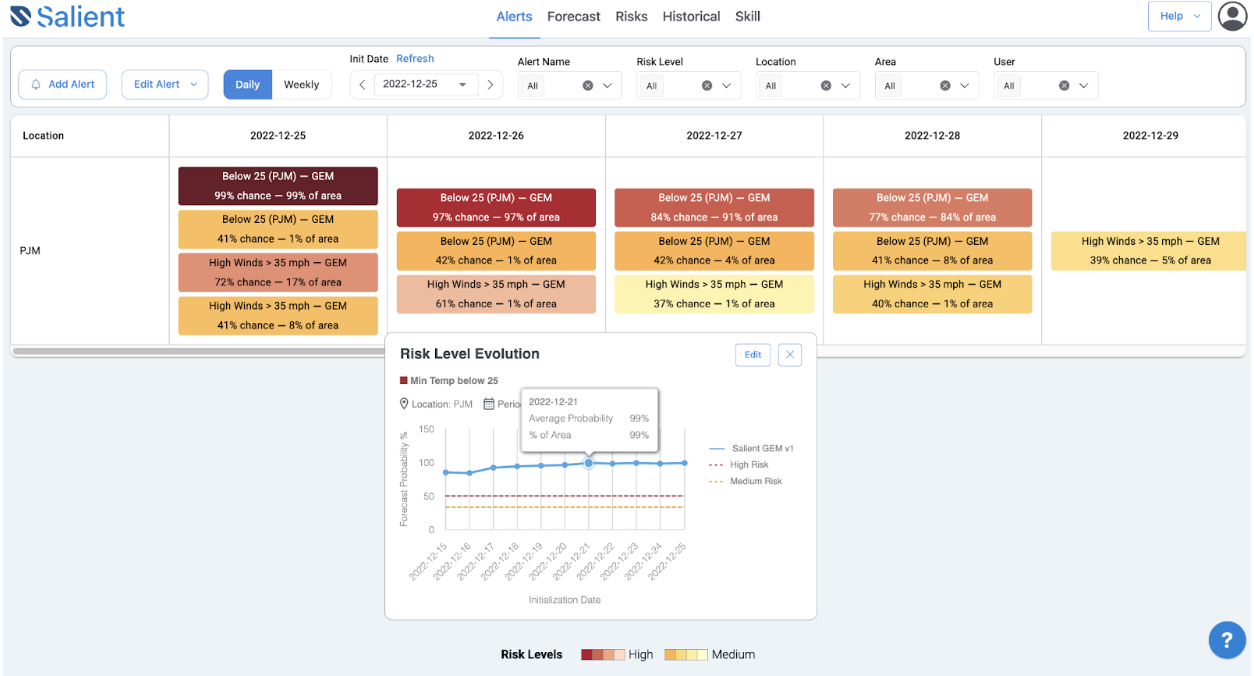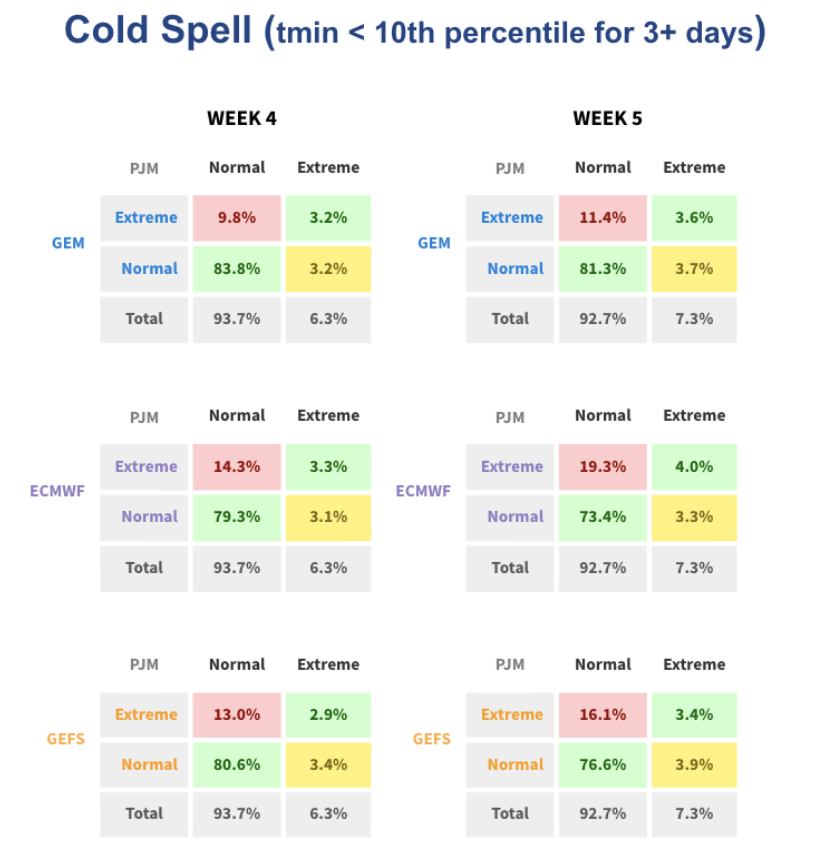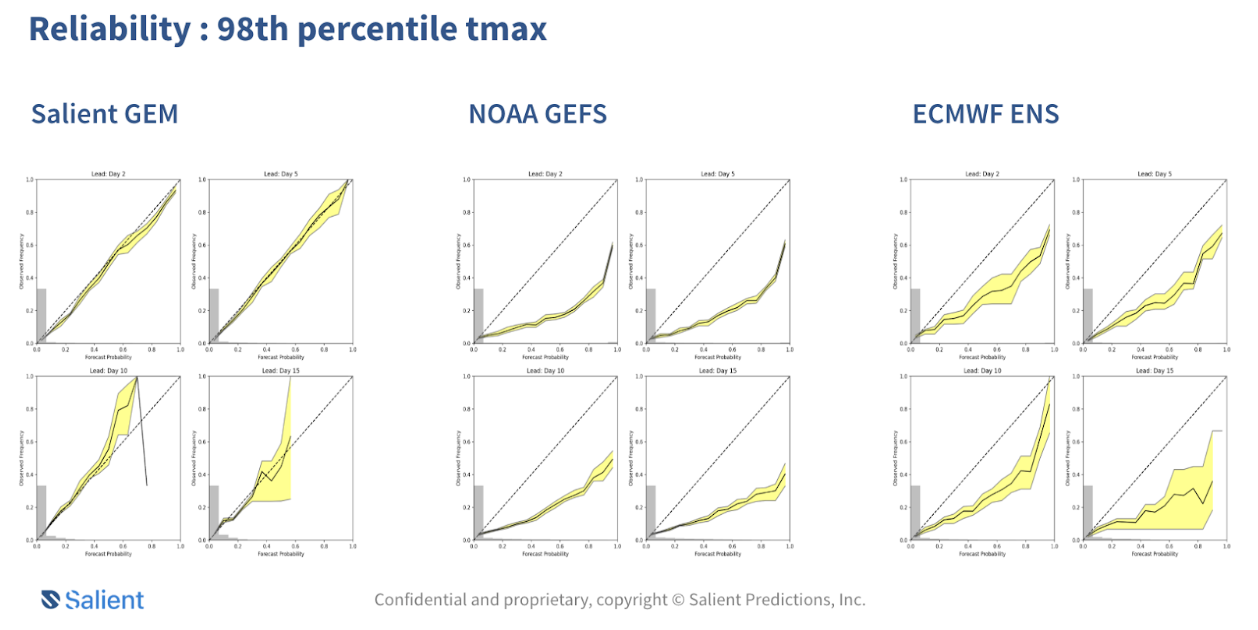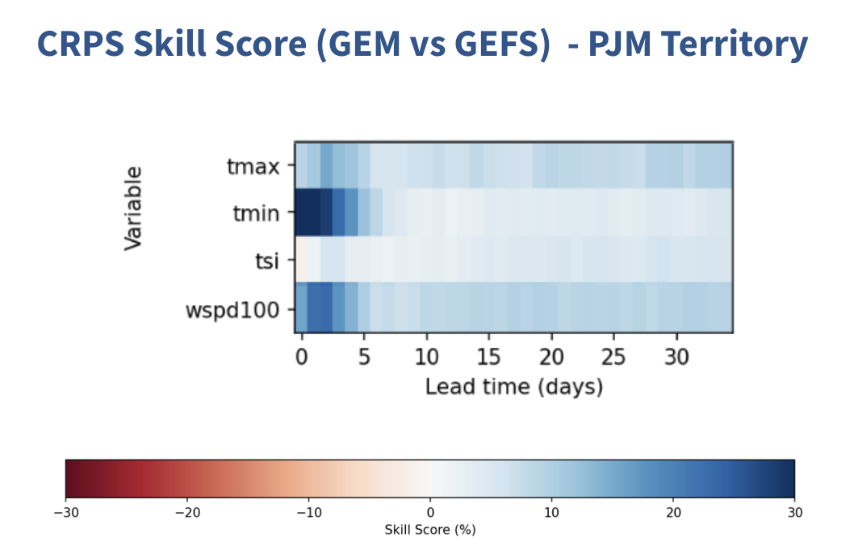
September 18, 2025
September 18, 2025
Smarter Forecasts: Weather Intelligence for PJM

PJM’s Weather Challenges
In July, PJM capacity prices set another record with a 22% jump as load grew by about 5,500 MW, mainly from data centers. The pace of adding generating resources isn’t keeping pace with rising electric demand. With tight supply constraints, unpredictable weather can be a major threat to grid stability. During Winter Storm Elliott (2022), peak demand coincided with generation shortfalls., forcing outages affecting 1.6 million customers on Christmas Eve.
The Future of Forecasting
Relying on deterministic forecasts a few days ahead and climatology from the last 30 years is no longer a sustainable path for keeping power flowing to customers in today’s uncertain, volatile energy environment.
Salient has been at the forefront of AI- and ML-driven weather prediction - helping energy companies face the challenges of supply-demand imbalance and climate-driven weather volatility. By learning from decades of historical observations (ECMWF ERA5) and real-time sensor data, our models can detect subtle signals and complex patterns hidden in the atmosphere.
The Salient GEM model forecasts further to 120 days, has more ensemble members (200), and is calibrated for reliability - major advantages compared to other AI- and traditional weather models. AI-powered predictions can confidently predict with longer lead times enabling better preparedness (see Figure 1).

Why Salient GEM Matters
✅ Outperforms public NWP models (NOAA GEFS, ECMWF ENS)
✅ Large ensembles (200 trajectories) provide deeper uncertainty quantification than traditional methods.
✅ Calibrated and reliable, supporting better decision-making across the forecast horizon.
✅ Skillful forecasts up to 120 days, with daily resolution.
✅ Business-critical variables: temperature (min/max/mean), CDD/HDD, precipitation, humidity, wind (10m, 100m, gusts, direction), solar, cloud cover, wind chill, heat index, and metrics related to weather regimes (500mb geopotential height, MSLP).
✅ Hindcasts from 2020-10-16 to present for evaluating past forecasts
How Utilities are Transforming Operations
⚡ Extreme Weather Risk
The grid remains vulnerable to extreme weather events which are increasing in frequency and unpredictability. While PJM has improved its short-term forecasting processes, based on recommendations from its WSE report, opportunities remain to strengthen preparedness for extreme weather. Traditional forecasts often struggle with timing and magnitude, leading to either missed events or costly false alarms. GEM reduces these risks by:
- Extending forecast visibility beyond 10 days.
- Providing larger ensemble spreads (200 members, twice that of most dynamical models) to capture full distribution of possible outcomes and extremes
- Maintaining lower false alarm rates while preserving hit rates (see Figure 2). Salient’s false alarm rate for cold spells, defined as minimum temperature below the 10th percentile of climatology for 3 or more days) was 11.4% for lead week 5 compared to 19.3% for ECMWF and 16.1% for GEFS.
This enables utilities to forecast demand more accurately, allocate resources more efficiently, and proactively respond to extreme conditions.

🔌 Grid Reliability in a Renewable Future
As PJM shifts toward more solar and wind, maintaining reliability becomes even harder. Variable generation requires spatially coherent and probabilistic forecasts to manage risk.
- Projects like EPRI OPTSUN have shown how probabilistic solar forecasts can improve operations and reduce costs. Additionally, load and solar are influenced by the same weather.
- GEM supports load and renewables forecasting by ensuring spatio-temporal consistency across variables—critical when trying to predict the likelihood of simultaneous weather phenomena like heatwaves paired with wind droughts.
Salient’s reliable probabilistic forecasts allow operators to plan for complex, multi-day, multivariate events with confidence (see Figure 3).

💵 Smarter Hedging Strategies
At longer lead times, energy producers and operators will want to hedge fuel/gas contracts to smooth out exposure to changing prices. There is heightened risk during winter and summer months when even small forecast errors can swing gigawatts of load expectations—leading to costly over- or under-hedging. Hydro-Quebec has already proven that the use of probabilistic, long-range forecasts reduced purchase hours by 7% and cut supplemental energy requirements by around 20%.
With GEM, utilities and traders can:
- Quantify uncertainty and variance from climatology.
- Optimize long-range contracts and budgets.
- Better anticipate best- and worst-case price scenarios.

Conclusion
For PJM and its utilities, reliability is paramount. Salient’s predictive weather intelligence helps strengthen reliability and lower costs by enabling:
- Better anticipation of extreme weather risk
- More accurate load and renewable forecasts.
- Smarter, lower-risk fuel and gas hedging decisions.
With GEM, utilities gain a clearer, longer, and more reliable view of weather-driven risk—enabling proactive action instead of reactive responses. Salient is currently partnering with a number of innovative utilities who are adopting AI-weather forecasts to transform operations for the future.
👉Contact us to learn more about how Salient can help you.
September 18, 2025
September 18, 2025
Smarter Forecasts: Weather Intelligence for PJM

PJM’s Weather Challenges
In July, PJM capacity prices set another record with a 22% jump as load grew by about 5,500 MW, mainly from data centers. The pace of adding generating resources isn’t keeping pace with rising electric demand. With tight supply constraints, unpredictable weather can be a major threat to grid stability. During Winter Storm Elliott (2022), peak demand coincided with generation shortfalls., forcing outages affecting 1.6 million customers on Christmas Eve.
The Future of Forecasting
Relying on deterministic forecasts a few days ahead and climatology from the last 30 years is no longer a sustainable path for keeping power flowing to customers in today’s uncertain, volatile energy environment.
Salient has been at the forefront of AI- and ML-driven weather prediction - helping energy companies face the challenges of supply-demand imbalance and climate-driven weather volatility. By learning from decades of historical observations (ECMWF ERA5) and real-time sensor data, our models can detect subtle signals and complex patterns hidden in the atmosphere.
The Salient GEM model forecasts further to 120 days, has more ensemble members (200), and is calibrated for reliability - major advantages compared to other AI- and traditional weather models. AI-powered predictions can confidently predict with longer lead times enabling better preparedness (see Figure 1).

Why Salient GEM Matters
✅ Outperforms public NWP models (NOAA GEFS, ECMWF ENS)
✅ Large ensembles (200 trajectories) provide deeper uncertainty quantification than traditional methods.
✅ Calibrated and reliable, supporting better decision-making across the forecast horizon.
✅ Skillful forecasts up to 120 days, with daily resolution.
✅ Business-critical variables: temperature (min/max/mean), CDD/HDD, precipitation, humidity, wind (10m, 100m, gusts, direction), solar, cloud cover, wind chill, heat index, and metrics related to weather regimes (500mb geopotential height, MSLP).
✅ Hindcasts from 2020-10-16 to present for evaluating past forecasts
How Utilities are Transforming Operations
⚡ Extreme Weather Risk
The grid remains vulnerable to extreme weather events which are increasing in frequency and unpredictability. While PJM has improved its short-term forecasting processes, based on recommendations from its WSE report, opportunities remain to strengthen preparedness for extreme weather. Traditional forecasts often struggle with timing and magnitude, leading to either missed events or costly false alarms. GEM reduces these risks by:
- Extending forecast visibility beyond 10 days.
- Providing larger ensemble spreads (200 members, twice that of most dynamical models) to capture full distribution of possible outcomes and extremes
- Maintaining lower false alarm rates while preserving hit rates (see Figure 2). Salient’s false alarm rate for cold spells, defined as minimum temperature below the 10th percentile of climatology for 3 or more days) was 11.4% for lead week 5 compared to 19.3% for ECMWF and 16.1% for GEFS.
This enables utilities to forecast demand more accurately, allocate resources more efficiently, and proactively respond to extreme conditions.

🔌 Grid Reliability in a Renewable Future
As PJM shifts toward more solar and wind, maintaining reliability becomes even harder. Variable generation requires spatially coherent and probabilistic forecasts to manage risk.
- Projects like EPRI OPTSUN have shown how probabilistic solar forecasts can improve operations and reduce costs. Additionally, load and solar are influenced by the same weather.
- GEM supports load and renewables forecasting by ensuring spatio-temporal consistency across variables—critical when trying to predict the likelihood of simultaneous weather phenomena like heatwaves paired with wind droughts.
Salient’s reliable probabilistic forecasts allow operators to plan for complex, multi-day, multivariate events with confidence (see Figure 3).

💵 Smarter Hedging Strategies
At longer lead times, energy producers and operators will want to hedge fuel/gas contracts to smooth out exposure to changing prices. There is heightened risk during winter and summer months when even small forecast errors can swing gigawatts of load expectations—leading to costly over- or under-hedging. Hydro-Quebec has already proven that the use of probabilistic, long-range forecasts reduced purchase hours by 7% and cut supplemental energy requirements by around 20%.
With GEM, utilities and traders can:
- Quantify uncertainty and variance from climatology.
- Optimize long-range contracts and budgets.
- Better anticipate best- and worst-case price scenarios.

Conclusion
For PJM and its utilities, reliability is paramount. Salient’s predictive weather intelligence helps strengthen reliability and lower costs by enabling:
- Better anticipation of extreme weather risk
- More accurate load and renewable forecasts.
- Smarter, lower-risk fuel and gas hedging decisions.
With GEM, utilities gain a clearer, longer, and more reliable view of weather-driven risk—enabling proactive action instead of reactive responses. Salient is currently partnering with a number of innovative utilities who are adopting AI-weather forecasts to transform operations for the future.
👉Contact us to learn more about how Salient can help you.
About Salient
Salient combines ocean and land-surface data with machine learning and climate expertise to deliver accurate and reliable subseasonal-to-seasonal weather forecasts and industry insights—two to 52 weeks in advance. Bringing together leading experts in physical oceanography, climatology and the global water cycle, machine learning, and AI, Salient helps enterprise clients improve resiliency, increase preparedness, and make better decisions in the face of a rapidly changing climate. Learn more at www.salientpredictions.com and follow on LinkedIn and X.



